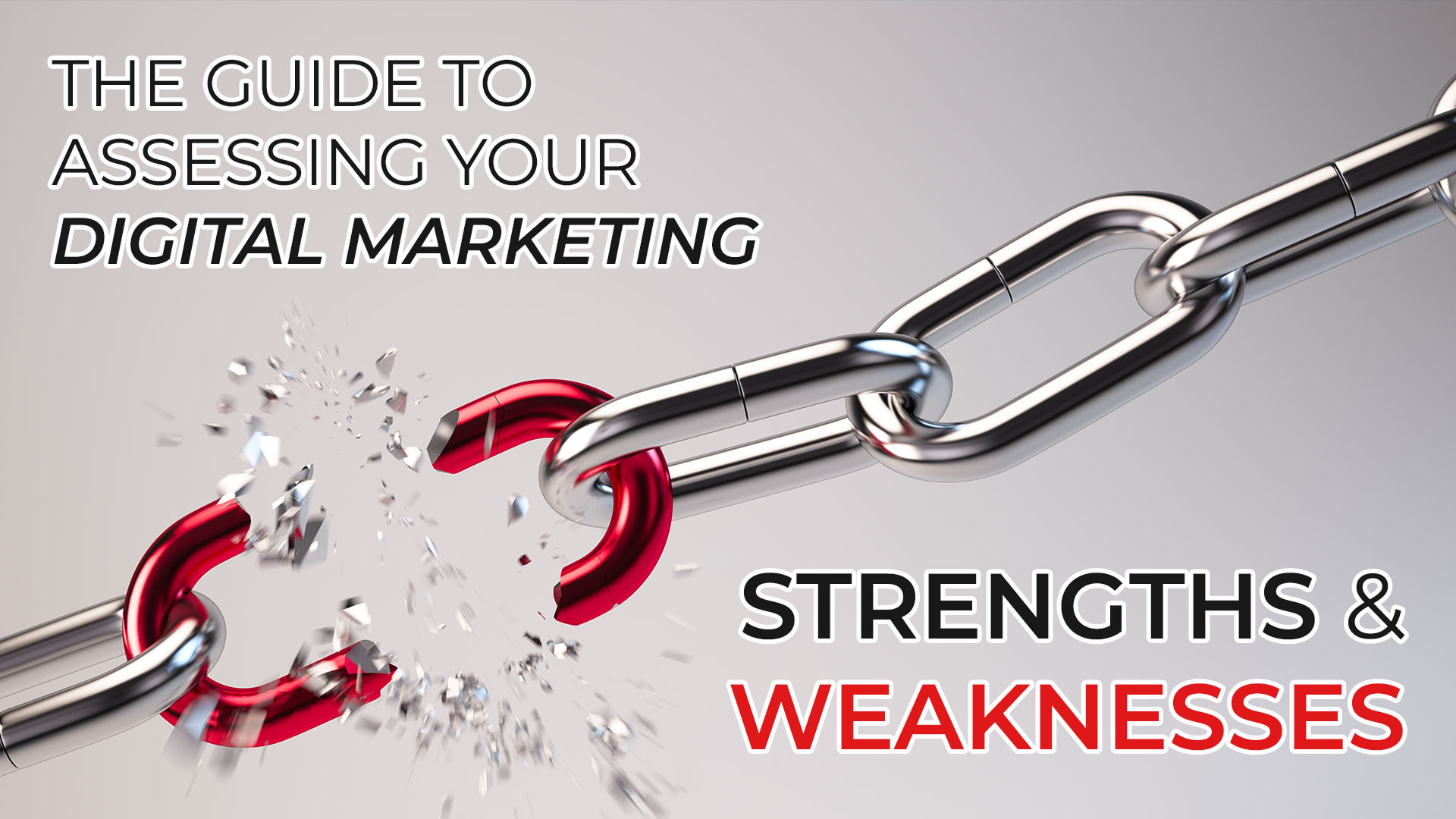
The Guide to Assessing Your Digital Marketing Strengths and Weaknesses
Evaluating your digital marketing efforts is akin to a health check-up for your brand’s online well-being. It allows you to measure the pulse of your marketing campaigns, examine the efficacy of your strategies, and ensure that every effort aligns with your overarching business goals.
Whether you’re looking to increase brand awareness, generate leads, or strengthen customer loyalty, a thorough digital marketing assessment provides valuable insights that inform smarter, data-driven decisions.
At Social Firm, we understand that when it comes to crafting digital marketing strategies that get results, one size does not fit all. That’s why our approach is rooted in gaining a clear understanding of each client’s unique value proposition, target audience, and business objectives. Only by assessing your digital marketing efforts can we help you identify your competitive advantage and focus on strategies that matter most to your success.
In this blog, we’ll share what you should look for while assessing your digital marketing strengths and weaknesses and how to craft the best strategies based on those findings.
There’s a lot to consider, so let’s jump right in.

Understanding the Basics of Digital Marketing Assessment
What is a digital marketing assessment? At its core, it’s a methodical process for evaluating your digital campaigns across various tools and platforms, measuring their effectiveness in meeting your defined business objectives.
This assessment spans several key areas, including your website’s design and functionality, your SEO performance, the engagement levels on your social media profiles, the success of your email marketing campaigns, and the use of paid advertising to attract potential customers.
To identify your strengths, we consider the aspects of your digital marketing that are performing well. These could be high conversion rates on landing pages, significant organic traffic due to strong SEO practices, or high levels of customer engagement on social media channels. Recognizing these strengths is not just about giving yourself a pat on the back; it’s about understanding what works so you can continue to invest in and optimize these successful areas.
Conversely, pinpointing weaknesses requires a candid look at what’s not working. Lower-than-expected click-through rates, a high bounce rate on your website, or lackluster customer feedback are all indicators that certain strategies may need reevaluation. This part of the assessment is crucial—it’s where the real work begins.
By identifying these weaknesses, you can start troubleshooting problems, reallocating resources, and testing new approaches to improve your overall digital marketing performance.

Identifying Your Digital Marketing Goals
Before beginning any digital marketing efforts, it’s imperative to set clear goals that everyone on your team can agree on. But what makes a goal well-defined and effective? It must be SMART: Specific, Measurable, Achievable, Relevant, and Time-bound.
Specific goals narrow your focus, ensuring that your marketing efforts are targeted and deliberate. Measurable goals allow you to track progress and quantify success, providing a concrete benchmark to strive for.
Establishing achievable, relevant goals ensures that your digital marketing remains aligned with your broader business strategy and your company’s overarching vision. Time-bound goals create a sense of urgency and momentum, keeping your team motivated and focused.
So, aligning your digital marketing goals with your overall business objectives isn’t just a good practice—it’s essential. For instance, if your business goal is to launch a new product, your digital marketing goal might be to generate buzz and anticipation through a targeted social media campaign.
If your objective is to enter a new market, your digital marketing might focus on building brand awareness within that market through strategic content marketing and localized SEO. Or, if improving customer loyalty is your aim, you might prioritize engaging with your audience through personalized email marketing campaigns and social media interaction.
In each case, the digital marketing goals act as milestones on the path to achieving your business objectives. They provide a roadmap for your marketing team to follow, ensuring that every effort contributes to the broader success of your company.
By aligning your digital marketing goals with business goals, you can ensure that every tweet, blog post, and ad is a step toward the future you envision for your brand.

Knowing Your Target Audience
The heartbeat of any successful digital marketing campaign is the audience it serves. Each segment of your audience has unique preferences, pain points, and expectations. When you understand these intricacies, you can tailor your digital marketing strategies to speak directly to their desires and needs, creating a more personalized and impactful experience.
To gain these valuable insights, there are several techniques you can employ:
- Customer Surveys and Feedback
- Social Media Analytics
- Website and Behavioral Analytics
- Market Segmentation
- Persona Development
- Competitive Analysis
- Customer Journey Mapping
By leveraging these techniques, you can develop a clearer picture of your target audience and refine your digital marketing campaigns to better meet their needs. But remember, your audience’s preferences and behaviors are constantly evolving. So, staying attuned to these changes and adapting accordingly is crucial to crafting messages that cut through the noise and inspire connection.

Analyzing Your Current Digital Presence
To understand the effectiveness of your digital marketing efforts, you must first take a step back and evaluate this presence, starting with two critical components: your website traffic and mobile responsiveness.

Website Traffic: Start Your Engines!
Website traffic is more than just numbers; it’s the engine that drives your online ecosystem. It provides you with a clear indication of how well your content is performing, what attracts visitors to your site, and where there might be room for improvement.
Monitoring website traffic with tools like Google Analytics (or, more accurately, GA4) gives you access to invaluable data, such as the number of visitors, how they found your website (organic search, direct visits, referral links, etc.), which pages are most popular, and how long visitors stay on your site.
This data not only helps you gauge interest in your content but also enables you to optimize your user experience to keep traffic high and bounce rates low.

Your Audience is on The Move
84% of Americans own a smartphone, and at least 79% of them used their phone to make a purchase within the last six months!
So, mobile responsiveness is another non-negotiable aspect of your digital presence. With the majority of internet users accessing the web via mobile devices, a website that isn’t mobile-friendly is akin to a shop with a closed sign. It must be navigable, fast-loading, and visually appealing on any device.
Google’s Mobile-Friendly Test or similar tools can help you evaluate your website’s mobile responsiveness, ensuring that you’re not inadvertently turning away a significant portion of your potential audience.
Beyond regularly reviewing your website’s performance, it’s crucial to conduct thorough evaluations of other digital channels to ensure they are contributing effectively to your overall strategy.

Social Media Engagement Analysis
Each of the social media platforms for which your company has an account has analytics tools you should use regularly to assess audience engagement. The metrics to consider include likes, comments, shares, followers growth rate, and the reach of your posts.
By examining these indicators, you can gauge the effectiveness of your content, identify which types of posts resonate most with your audience, and adjust your social media strategy accordingly. Analyzing engagement trends can also help you pinpoint the best times to post content and which platforms are most favorable for your brand.

Email Marketing Campaign Assessment
Email remains a powerful tool for direct communication with your customers. To measure the success of your email campaigns, closely monitor open rates, click-through rates, and conversion rates. These metrics offer insights into how compelling your subject lines are, the relevance of your content, and the persuasiveness of your calls to action.
By integrating advanced tracking tools with your email marketing software, you can track recipient behaviors in detail, such as which links are clicked and what actions are taken post-click.
Segmenting your audience and tailoring your messaging to different segments can significantly boost engagement rates and ensure your emails provide value to each specific group within your audience.
Regular assessments in these areas will provide a comprehensive view of your digital presence, allowing you to make informed decisions and optimize your digital marketing efforts for better engagement and conversion.

Recognizing Strengths and Addressing Weaknesses
If you’ve gone through the process of gathering quality data, don’t ignore it! Data reveals the reality of your marketing efforts beyond subjective opinions or hunches. It also pinpoints your company’s strengths—those elements that are driving success and resonating with your audience.
Simultaneously, you can also uncover weaknesses or areas that are falling short of your expectations and need to be addressed.

What to Consider When Addressing Weaknesses?
A/B Testing: Implement A/B testing for various elements of your digital campaigns to determine what resonates best with your audience. Be agile and act on the results.
Customer Feedback: Actively listen to customer feedback using surveys, social media interactions, and review platforms to gather insights and identify areas for improvement.
Personalization: Personalize your marketing messages based on customer data and behavior. Tailored recommendations and targeted offers can make customers feel valued and more likely to stay loyal to your brand.
Consistent Branding: Maintain consistent branding across all digital channels. This includes using a unified tone of voice, visual style, and messaging that reflects your brand’s values and mission. Consistency helps build recognition and trust among your audience.
Engagement: Engage with your audience regularly and respond promptly. Try creating some interactive content such as polls, quizzes, or live Q&A sessions to foster a sense of community around your brand.
Value Proposition: Clearly communicate your brand’s unique value proposition. Help your audience understand what sets you apart from competitors and why they should choose your brand.
Customer Experience: Focus on providing an exceptional customer experience at every touchpoint. From seamless website navigation to hassle-free returns, every aspect of the customer journey should reinforce positive feelings about your brand.

What to Consider When Addressing Strengths?
While strengths should be celebrated, consider there’s always room for improvement. Don’t just “rinse and repeat.” As you identify areas for improvement, you can take action to optimize them. Consider implementing the following tactics:
Invest in Continuous Learning: Encourage your marketing team to stay educated on industry best practices and emerging technologies. This can be achieved through online courses, attending webinars, or subscribing to industry publications.
Leverage Data Analytics: Use data analytics tools to monitor campaign performance and gather insights on customer behavior. This data can help inform decisions about where to innovate or make strategic adjustments.
Experimentation: Don’t be afraid to experiment with new platforms or marketing techniques. Early adoption can give you a first-mover advantage and set you apart from competitors.
Customer-Centricity: Always keep your customer at the heart of your strategy. By understanding and anticipating their needs, you can tailor your marketing efforts to provide solutions that truly resonate.
Flexibility: Build flexibility into your digital marketing plans to allow for quick pivots in response to sudden market changes or unexpected opportunities.

Charting Your Digital Destiny: The Iterative Path to Successful Digital Marketing
An iterative approach when assessing your company’s digital marketing strengths and weaknesses allows you to pivot and adapt, ensuring your digital marketing strategy remains relevant and effective.
By regularly revisiting and refining your strategy, you can respond proactively to new opportunities and challenges, ultimately steering your brand toward sustained growth and success. And taking a very sober, clear-eyed approach to collecting and analyzing data will allow you to make the most of your digital marketing investments.
Take the first step towards unlocking the full potential of your digital presence. Contact The Social Firm today for a personalized digital marketing assessment and begin the journey to achieving your business objectives with clarity and confidence.
Let’s create a strategy that meets the current digital moment and anticipates the future, ensuring your brand’s digital marketing success.
Social Firm
Newsletter Sign-Up
If you loved this article, there's more where that came from. Stay up-to-date with marketing and design insights.